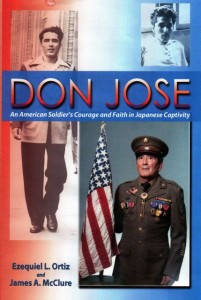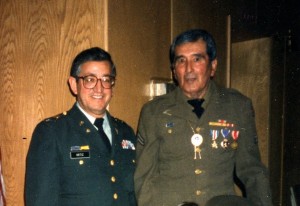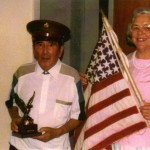An American Soldier’s Courage and Faith in Japanese Captivity
A book by Ezequiel L. Ortiz and James A. McClure
Years ago, an Army officer promised a veteran of World War II that he would write his story. The result is DON JOSE, An American Soldier’s Courage and Faith in Japanese Captivity. The book published in 2012 and is available from Sunstone Press and Amazon.com.
 The central story is about Joseph O. Quintero, a Hispanic soldier who was one of many American GIs who survived impossible conditions in Japanese prisoner of war camps. But the book is more than a biography.
The central story is about Joseph O. Quintero, a Hispanic soldier who was one of many American GIs who survived impossible conditions in Japanese prisoner of war camps. But the book is more than a biography.
It’s an enlisted man’s view of one of the first desperate battles of the war, supplemented by a military overview of the battle for Corregidor and its context in the opening round of the Pacific campaign. It’s a vivid look at life in the POW camps: what Americans endured and what they did to survive. And it’s the story of how one man’s religious faith and concern for his buddies sustained him and helped others.
 The book won first place for biography in the National Federation of Press Women’s competition in 2013.
The book won first place for biography in the National Federation of Press Women’s competition in 2013.
Joseph’s story
Colonel Zeke Ortiz first became acquainted with Joseph O. Quintero in the course of interviewing veterans of World War II while on active duty in the U.S. Army. They became friends for more than 20 years. Before Joseph died in 2000 at the age of 82, he asked Zeke to write his story.
Joseph’s story is an enlisted man’s view of the war with first-hand descriptions of conditions in the POW camps and personal glimpses of what he and his buddies did, endured and talked about.
We included a chapter about Joseph’s family because where he came from shaped his character, and equipped him to become a survivor and a hero. Growing up in the poverty of a Mexican-immigrant family living in a converted railroad caboose, with tortillas and onions for breakfast, prepared him for the hard life and starvation diet of the POW camps. After the war, Joseph added a big dining room to his modest home in Albuquerque and made sure that no visitor left hungry.
Another theme that runs through the book is the deep religious faith Joseph learned from his mother. His faith sustained him during the war, and much of his later life focused on service to his local parish.
Joseph achieved a degree of fame after the war as the “miracle man” who survived a razor-blade appendectomy aboard a Japanese “hell ship,” and for his homemade American flag fashioned in secrecy in the POW camp.
A more important distinction, however, was the bond Joseph established with his fellow POWs. He went out of his way to help wounded, sick and injured POWs as a medic. Joseph’s reputation for saving lives earned him the honorific nickname of Don Jose. His buddies reciprocated by helping to keep him alive after his surgery at a time when scores of other POWs died on the perilous voyage to Japan.
During the battle for Corregidor, Joseph was one of only 17 of the 119 members of his unit to earn the Silver Star, the second-highest decoration for heroic action in combat. In characteristic modesty, his own narrative says little about his personal actions during the battle.
Joseph’s friendship with his fellow POWs was what brought him to Albuquerque to build a new life after the war and raise his family.
Joseph’s narrative forms the framework of this book. In addition, we have included research on the defense of Corregidor and the Japanese prison camps and crosschecked facts from multiple sources. Also included are official documents and personal photos supplied by members of the Quintero family.
Researching Don Jose
Joseph Quintero’s account of his experiences was drawn from journals he wrote after the war, and from numerous interviews with the Quintero family and Joseph himself. Over the years others have written about Joseph in newspaper stories and books, and these accounts are included in Joseph’s book.
Not all of these stories were in agreement. One description of Joseph’s emergency appendectomy got his name wrong. Another account said the operation was performed by a veterinarian and a third claimed the doctor was drunk. (The fact that Joseph survived indicates that the doctor knew what he was doing.)
One writer said that when the war ended, Joseph led the liberated POWs aboard a hospital ship with his homemade American flag. That’s a good story, but Joseph said he left the POW camp by train and boarded an airplane in Tokyo. Navy records showed that no hospital ship was in the area (and besides, the harbor was still mined at that point).
As a prisoner of war, Joseph had no way of knowing how the war was going. The book puts Joseph’s experiences into context by noting the progress of the Pacific campaign at and its impact on American POWs. Sources include other histories and military records.
Joseph’s concern for his fellow POWs is evident because his story includes a lot of information about the men he served with: who they were, how they lived and, in many cases, how they died. The names of nearly 100 individuals appear in the book. After the war, Joseph kept in touch with many of the men who shared his experience.
The battle for Corregidor
Much has been written about the Bataan Death March: the heroism of the outnumbered American troops in the Japanese invasion of the Philippines and the brutality they endured after their surrender. Less is known about the heroic defense of the island fortress of Corregidor, which held out for a month after Bataan’s defeat.
Appendices to the book supplement Joseph’s narrative with detailed information about the battle for Corregidor. The war diary of Joseph’s commanding officer is a day-by-day account of the battle and the surrender of American forces to the Japanese. It offers insight into the inner workings of a fighting unit by a commander who cared for his men and kept in touch with them after the war.
Another appendix outlines the organization of the 60th Coast Artillery with a complete roster of all the men who served in the regiment and what happened to them. Finally, an article from a military magazine reviews the performance of the coast artillery on Corregidor and what modern military units can learn from the battle.


